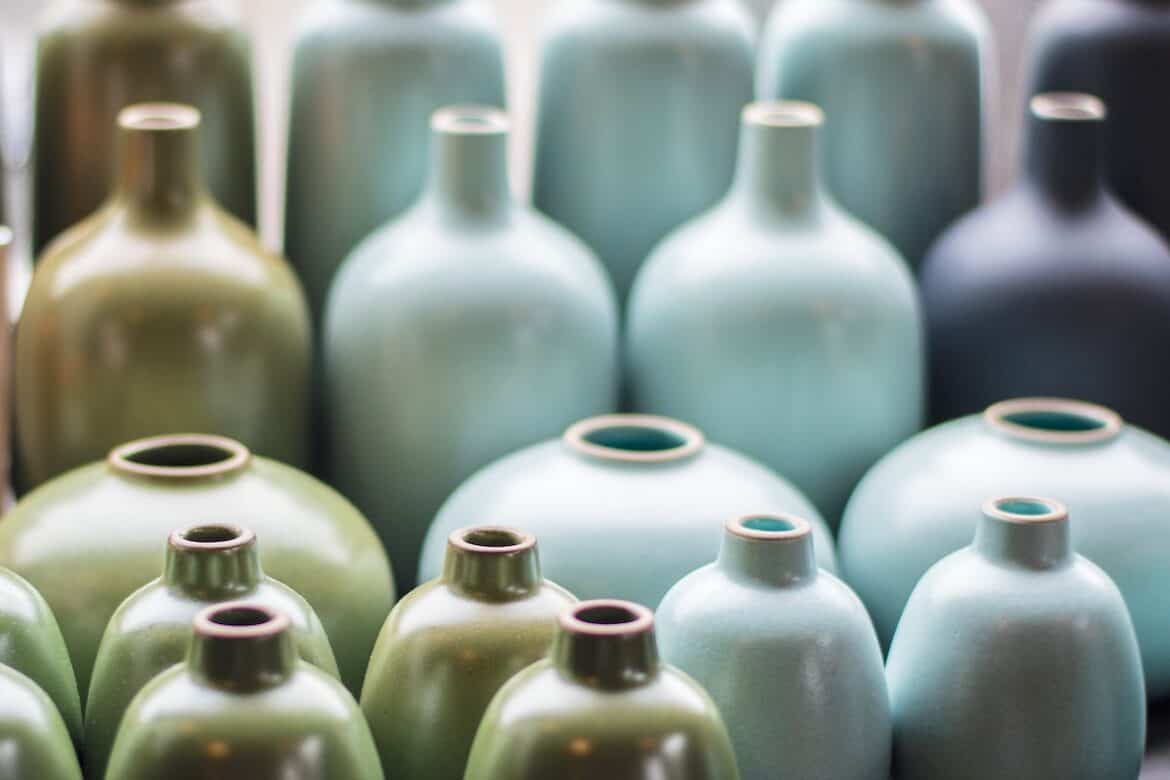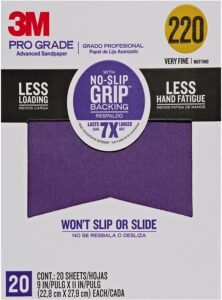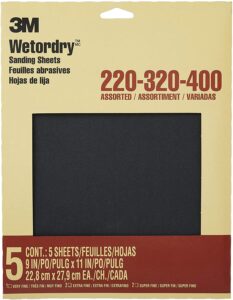It is not unusual for ceramics to turn out a little less than perfect. You might notice a sharp edge here, some rough-textured patch there, or an uneven bottom that makes your wares wobble.
Glazing isn’t of much help in concealing these flaws. Conversely, glazing a piece with such blemishes further draws attention to them because they tend to stick out more. You might even get bubbles or drips after glazing, adding to the imperfections.
What is the best sandpaper for ceramics? The best kind of sandpaper to remove burrs or drips, smooth rough edges, touch up the details, or level the base of ceramics is wet sandpaper with a grit between 180-400. Start with a coarser grit and work your way to a finer grit.
Sanding your ceramic wares after bisque firing or glazing remedies these rough, sharp, or uneven spots. It refines details, the overall aesthetic, and the feel, adding value to your craftsmanship.
To learn more about sanding ceramics, continue reading this post. There’s plenty of information on the best sanding papers and how to choose them, plus tons of other helpful tips.
Things To Look For When Choosing Sandpaper For Ceramics
Sandpapers are not created equal. Some are general-purpose, while others are specific for wood, metal, glass, or ceramics. To find the best sandpaper for ceramics, you must take into account the following factors.
1. Grit
Sandpaper does scratch ceramics, especially when dry sanding. For this reason, the grit must be top of your checklist. Sandpapers come in different grades, commonly referred to as grit and indicated by numbers. The smaller the number, the more abrasive the sandpaper.
You do not want coarse grit sandpaper because of potential scratches on porcelain in particular. 180-220 grit sandpaper is ideal to start with. Then you can go finer to 400 to polish up your pieces.
For porcelain that is ordinarily smooth and susceptible to scratches, it is better to start with ultra-fine sandpaper like 320-400 grit to see how it works. If not sure, broaden the variety to experiment with more options. But the type of clay you have should guide you in determining what grit to use.
Earthenware and stoneware clay is more likely to feel rugged when touched than porcelain. There’s also the element of grog to factor in.
2. Type Of Sandpaper
Aluminum oxide and silicon carbide are the two most prominent sandpapers available in the market. Silicon carbide sandpapers sand very finely and are ideal for smooth surfaces like ceramics.
Aluminum oxide sandpapers tend to be aggressive and suitable for surfaces that need more work, like removing a significant layer of material. They are not the best for ceramics unless that is the result you intend to get, for example, when leveling poorly balanced feet.
3. Capacity
When choosing sandpaper for ceramics, you must gauge its capabilities against the number of pieces/surface area you want to sand.
If you’re doing one small or medium piece or a little patch, you can go with ordinary sandpaper. But if you’re sanding in large-scale or a considerable part, you will need to replace the sandpaper too frequently, which is exhausting and uneconomical.
You might have to look at diamond pads or sanding screens. These are better sanding options for big tasks as they are durable.
4. Wet Sanding Ability
Ceramics must always be wet sanded. Sanding ceramics dry produces a lot of fine silica dust that is suspended in the air for days, posing severe health problems to anyone who inhales it.
Crafting is not all about fun but also responsibility. To keep yourself and those around you safe, opt for wet sanding. You can achieve this by either dunking the bisque fired piece in water first or soaking then using the wet sandpaper as you go. Instead of dust, you’ll create a sludge that you can wipe off.
Water also acts as a lubricant, preventing clogging. Clogged sandpaper creates deeper, wider scratches which are contrary to what you want to achieve by sanding.
Please note that not all sandpapers are made for wet sanding, so pay attention when making your purchase. Check for resin bonding, electroplated paper, and other waterproof qualities.
5. Convenience Features
How do you want to sand your ceramics? By hand, using a block, or a palm sander? Sandpapers come in different shapes and sizes, though you can always cut them to size to fit your needs.
Some features can be added to enhance the usability experience, for example, non-slip grip features for manual sanding or hooks and loops to attach to palm sanders.
The 5 Best Sandpapers For Ceramic
By now, you must be thinking, what is the best sandpaper for ceramics? The best sandpaper for ceramics is a very fine grit dry/wet sandpaper that won’t go too hard on the surface.
But there’s plenty of sandpaper brands. It is easy to fall prey to the wrong one and end up ruining your best work. Worry not because we already did thorough research for you and shortlisted from hundreds of products the 5 best sandpapers for ceramics.
| Rank | Product | Key Features |
|---|---|---|
| 1. | 3M Pro Grade 220 Grit Sandpaper | 220 grit, 20 sheets pro-grade, wet sand |
| 2. | Keama 120-5000 Assorted Grit Sanding Paper | 120-5000 grit, wet sand, silicone carbide |
| 3. | Z-Lion Diamond Abrasive Paper Sheets | 60-400 grit, 4 sheets, long-lasting |
| 4. | Poliwell Assorted Grit Sanding Sheets | 60-1000 grit, 50 sheets, wet & dry sanding |
| 5. | 3M Wetordry Assorted Grit Sandpaper | 220-320-400 grit, 5 sheets, wet or dry |
1. 3M Pro Grade 220 Grit Sandpaper
The 3M pro-grade advanced sandpaper is nothing like your ordinary sandpaper. It is designed to last much longer.
Pro-grade is a dry/wet sandpaper with anti-clogging properties. It enables you to wet sand your ceramics without fear of damaging the sandpaper or your wares.
The top surface is made with anti-slip technology, which enhances a firm grip. Using it is such a breeze. It gives you complete control with zero frustration.
Each pack contains 20 9×12-inch sheets of 220 grit sandpaper which is an excellent value as you can cut one sheet into smaller sizes as per your needs.
2. Keama 120-5000 Assorted Grit Sanding Paper
If you are not sure of the grit you need and want to buy a variety to try out cost-effectively, this is the product for you. The assortment of grit from the aggressive 120 to the light buffing 5000 grit sandpaper is satisfying.
The sandpaper is sturdily built with waterproof silicon carbide and an electroplated coated paper that doesn’t tear or crumble easily. They last a long time.
You’ll love how this sandpaper resists loading up when wet sanding. It doesn’t clog and works with the same efficiency. There are 45 sheets in a pack, 3 for each grit number. They measure 9 by 3.6-in with the grit number printed for easy identification and retrieval.
3. Z-Lion Diamond Abrasive Paper Sheets
The best sandpapers for ceramics are those designed precisely for that. This Z-Lion diamond sandpaper is one of the few.
It is well put together with electroplated bonds for enhanced useful life. The backing is made of cloth which makes it super flexible. It gets even in the tightest spots.
You get 4 relatively small sheets, measuring 3.54-in by 2.16-in, but they do a superior job on ceramics without the need for applying too much pressure. They come in a nice range of 60, 120, 200, and 400 grit.
4. Poliwell Assorted Grit Sanding Sheets
For versatile sandpapers that you can use by hand with a manual pad and a palm sander too, go for this products. The 4.5 by 5.5-in sheets come with the hook and loop for 1/4 inch sheet palm sanders and fits perfectly.
You get an impressive assortment of 10 different grades of sandpaper from 60 to 1000 grit.
There’s everything for the different types of ceramic clay, including grog and non-grog stoneware, earthenware, and porcelain at whatever stage, be it bisque fired or glazed.
There are five sheets for each grit number summing up to 50 sheets which is ample sandpaper to cater to all your sanding needs for a long time.
The quality is superior as it is made from ceramic silicon carbide, latex water, and heat-resistant paper and glue, which is eco-friendly too. It allows for both dry and wet sanding.
5. 3M Wetordry Assorted Grit Sandpaper
Last but not least is the wetordry sandpaper from a reputable brand which works amazing for wet sanding. You can expect the same efficiency as other 3M products.
This pack of sandpapers is made from silicon carbide with a paper backing bonded by resin. You are assured that it is waterproof and will not come apart while in use.
You get three different grades of sandpaper: 2 pcs 220 grit, 2 pcs 320 grit, and 1 pc 400. It is a fine selection for obtaining that silky smooth finish on your ceramics. You can’t go wrong with this brand.
Up Next: How To Seal Acrylic Paint On Ceramic Mugs





